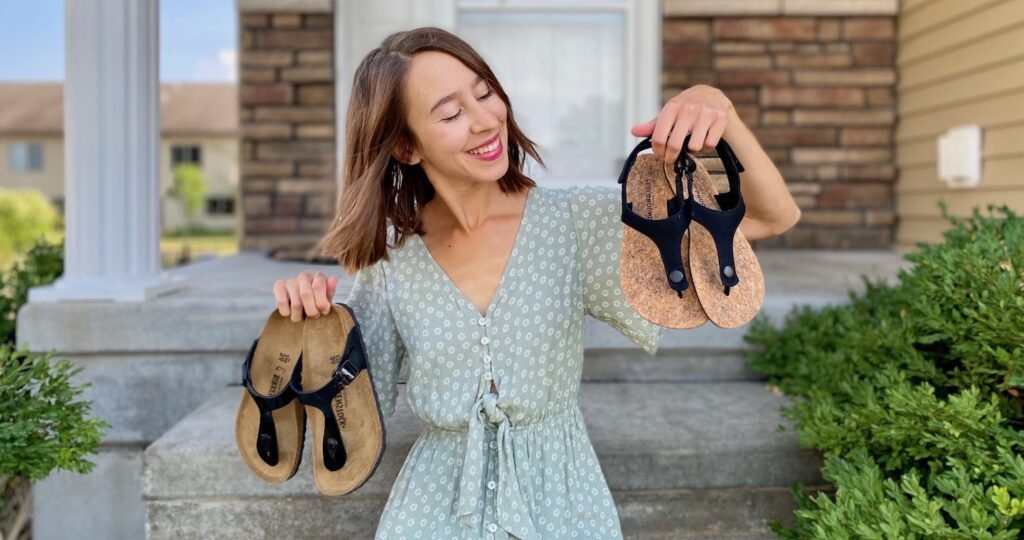
When I was experiencing severe foot pain, Birkenstocks saved me. The supportive foot bed and ample toe space was like a salve to my aching foot. In fact, they helped me become mobile again – no small thing when you have small children and a life to live. But a year passed and Birkenstocks were still the only shoe I could wear. Being barefoot, even in my house, was completely out of the question. So did my Birkenstocks really fix my foot pain, or did they just mask it?
In this article we talk about why strengthening your feet and wearing unsupportive shoes might be a better long term strategy for preventing foot issues than wearing Birkenstocks.
Arch Support Makes Your Feet Weak
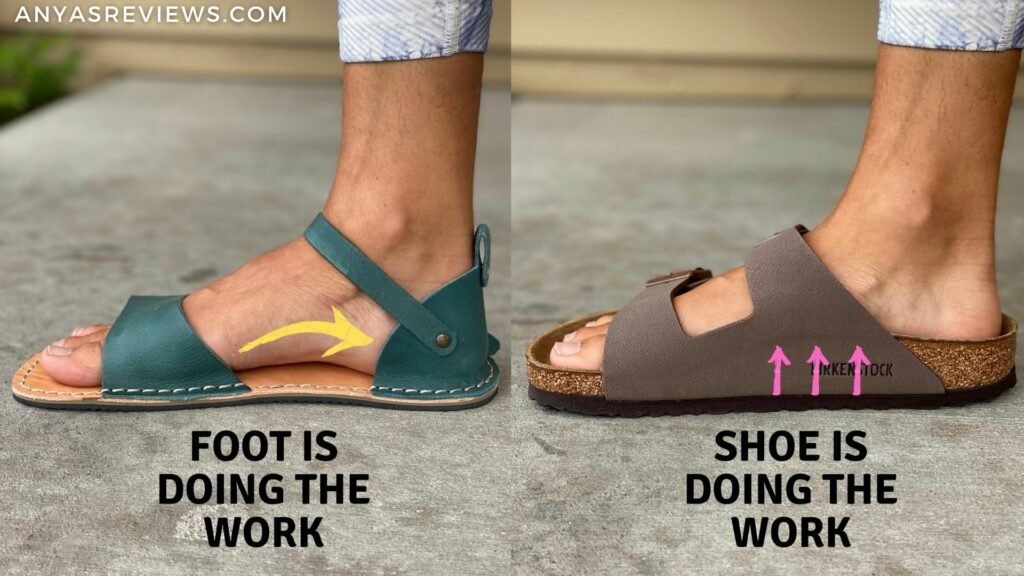
Currently there is a big disconnect between the way we think about feet and the way we think about the rest of the body. If you came to a physical therapist with a hurt shoulder you might be prescribed a temporary brace, but you would also be advised to mobilize and strengthen the area because if you brace the shoulder forever it will stop working.
And yet if you present with foot pain at the podiatrist’s office you’re likely to be prescribed a pair of orthotics, stiff shoes and an annual appointment to replace them – over and over for the rest of your life. Our feet are made of the same stuff as the rest of our body – muscles, ligaments, tendons, fascia. So why don’t we try to improve the function of our feet, instead of just bracing them in arch support forever?
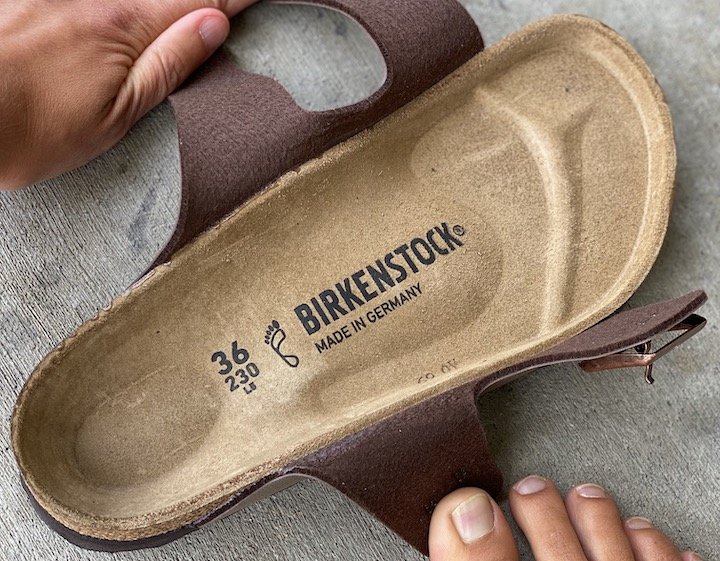
The first paradigm shift we need to embrace is that human feet are designed to work without external support. And while it can have therapeutic benefits for people in the short term, using arch support can actually make your feet weaker! We CAN regain foot strength, mobility, and stability with time and practice.
If your feet are deconditioned to support themselves, the arch in Birkenstocks can feel really good. But relying on arch support gives you no chance to use the muscles and nerves in your feet – tissues that, if strong and active, are more than up to the job of supporting you without any assistance. Most feet aren’t flawed, just underused. And simply wearing barefoot shoes is one way to fix that. Studies have shown that walking around in minimalist shoes naturally strengthens feet. Hence, arch support might help you today, but it’s not preparing you for tomorrow.
Stiff Soles Limit Your Foot Mobility
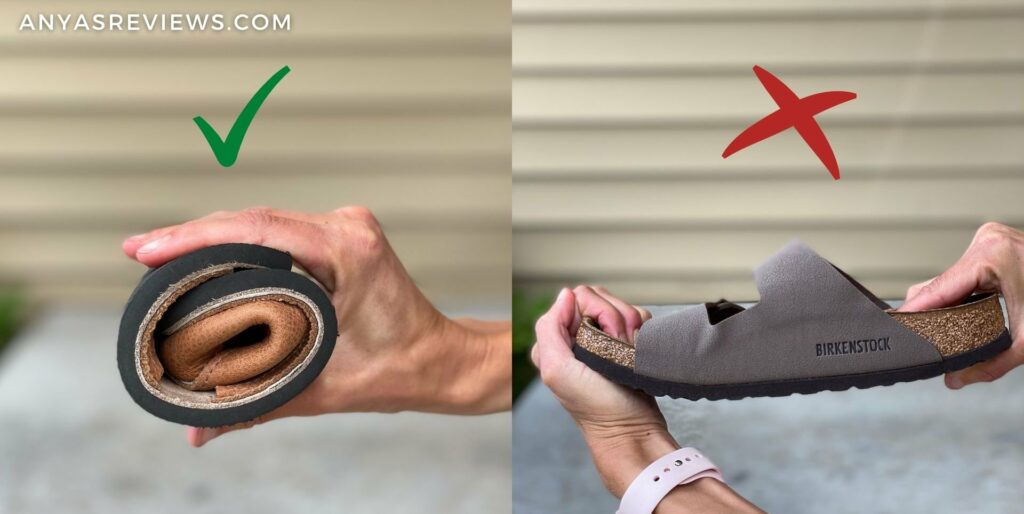
Besides weakening your foot musculature, the intense arch support and thick sole in a Birkenstock also limits your foot mobility. The foot has 33 joints, which allows for endless movement possibilities, all of which connect the feet to the entire posterior chain – ankles, knees, hips, pelvic floor, glutes.
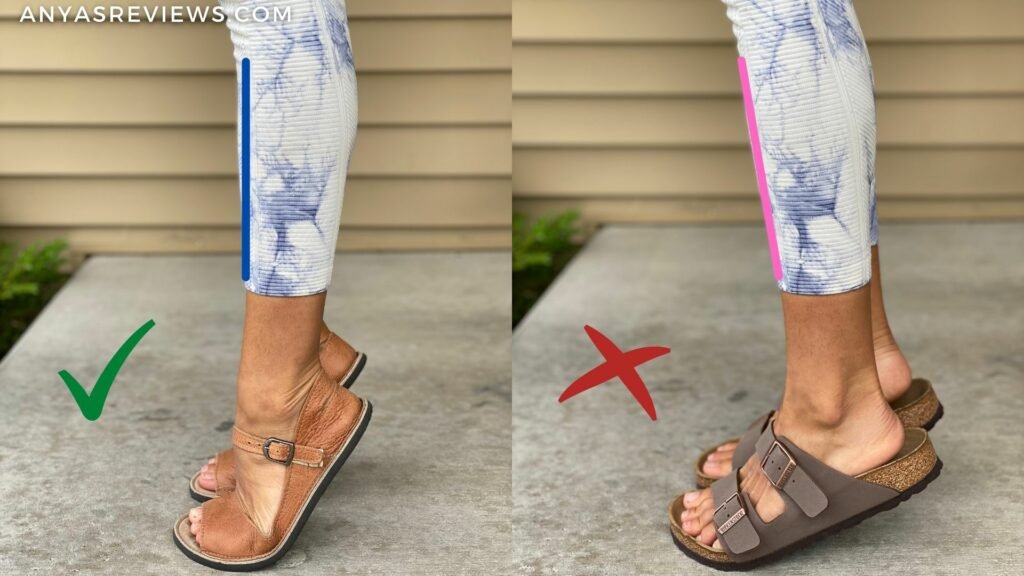
When you slip on a Birkenstock you are essentially putting your foot into a fixed position. You might get a little bending and flexing as you walk, but not nearly enough to keep your joints robust to meet the demands of a long and active life. Because if you don’t use your joint mobility you WILL lose it. Wearing shoes with flexible soles, i.e. not Birks, allows your toes to bend fully, your arch to flatten and stiffen as designed, and the natural balance system in the body to function. This stability from the ground up will come back to you in dividends throughout your life.
Slides Cause Toe Gripping
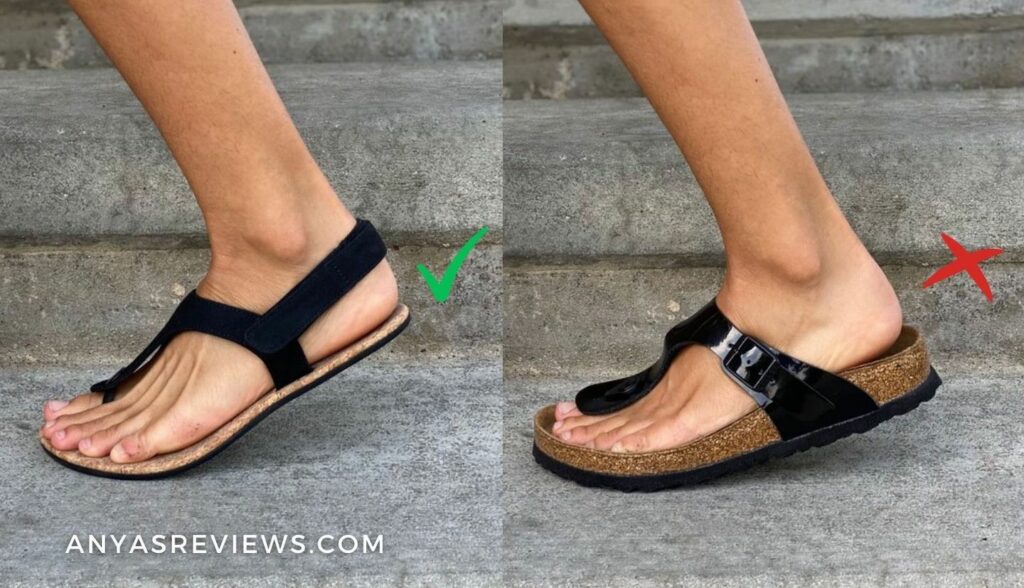
My final beef with Birks is that their most popular styles are essentially slides. Shoes that aren’t secure to your foot affect your gait, resulting in shuffling and toe gripping. For optimal mobility, sandals should have some sort of securing strap so they stay put while you move.
Birkenstock Got A Few Things Right
Despite the issues I have with Birkenstocks, they still hold a valuable place in the world of rehab and pain management – thanks to a few critical features.
Toe space
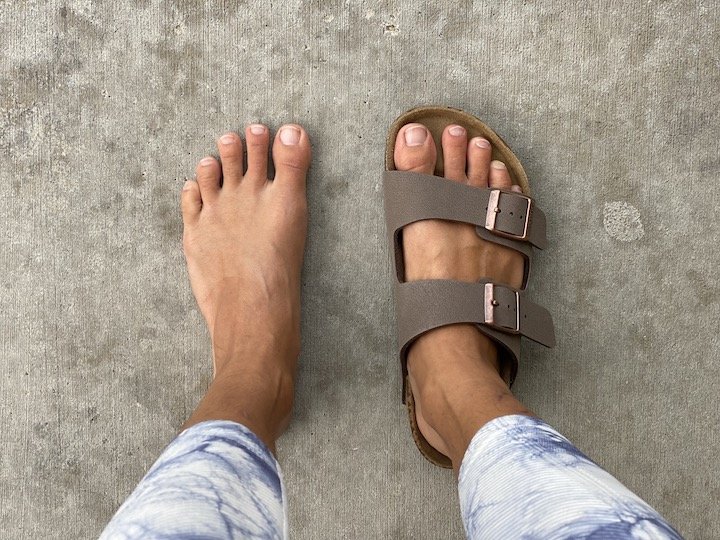
Birkenstock shoes have a natural foot shape that allows the toes to spread out. This is so important for foot function, and unfortunately so uncommon when you go shoe shopping. But that’s also what makes barefoot shoes so great – a natural toe box shape is a critical feature of them so if you transition to barefoot shoes you can say good bye to cramped feet!
Zero Drop
Birkenstock sandals are zero drop (heel is at the same elevation as the toe). This is another uncommon find in a supportive shoe (but an unequivocal feature of barefoot shoes), and is very beneficial to your spinal health and overall alignment. Any kind of heel, even the small heel lifts in sneakers and orthotic shoes, pushes your weight forward and stresses your body unevenly. If you need a supportive shoe right now, it goes a long way to get it in a completely flat one.
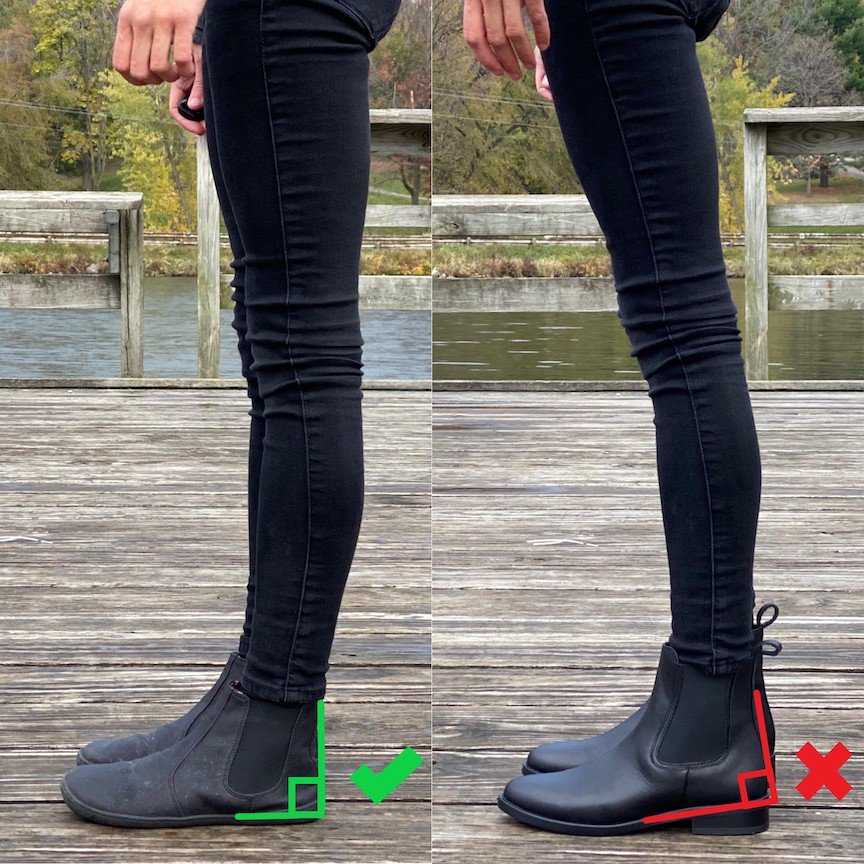
*Note that only Birkenstock sandals are zero drop. Their close toed shoes that come with a removable insole are not*
So if you are dealing with chronic or acute foot pain and need something to help get you by, you can do far worse than Birkenstock sandals. But relying on them in the long term will only serve to weaken your foot function over time. So what should we do instead?
The Better Long Term Solution to Foot Pain
If you’re living in Birkenstocks right now, no one is judging. After all, I spent more than a year wearing nothing but Birkenstocks – I know the vicious cycle of weak feet + supportive shoes all too well. But the good news is, you likely have more control than you realize. Foot health can be reduced to the following 4 aspects:
- Mobility – The range of motion you have control over
- Alignment – The natural positioning of your body’s joints
- Strength – The power and endurance of your muscles
- Stability – The ability to maintain alignment despite outside forces
So how do you achieve those things? Here are a few non-threatening ways to improve the health of your feet.
- Going barefoot
- Doing foot exercises
- Wearing minimalist shoes
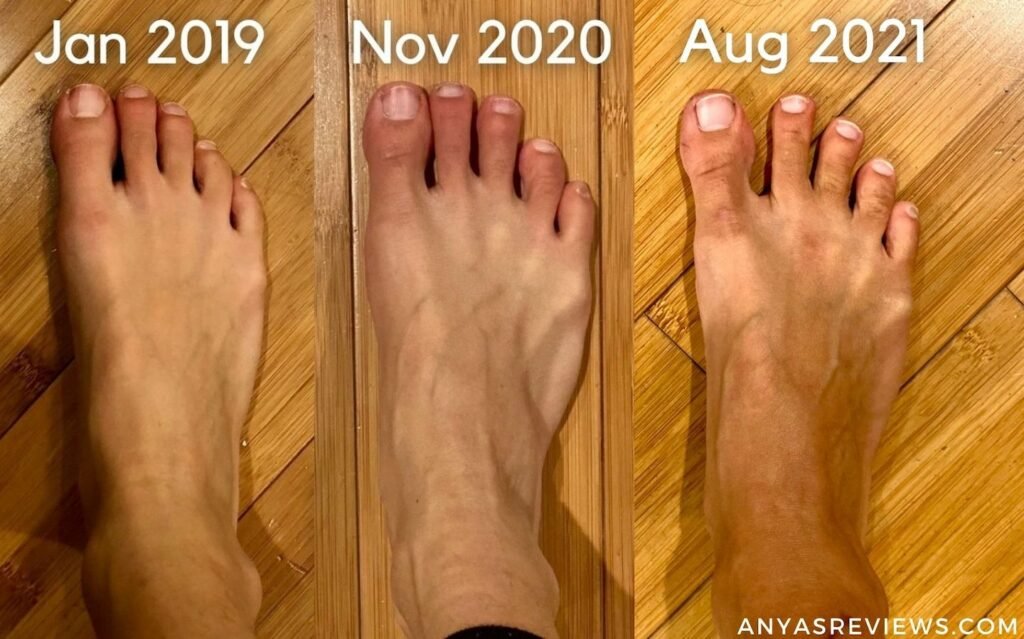
I used a combination of all 3 of the above strategies to get myself out of foot pain and out of arch support – for good! It can take time to see results, but real change is like that. Slow, steady progression over years has left me with two feet that stand on their own two feet! I discovered the concept of minimalist shoes in Jan. 2017 and slowly transitioned until Jan 2018 when I started wearing them exclusively. So the above photo shows what my foot looked like a year into my barefoot shoe journey (Jan 2019). 2 1/2 years later to Aug 2021 and you can visibly see that my foot is stronger and more aligned. Like they’ve been working out or something!
Below you can see the progression of my natural arch over 4 years. July of 2017 is when I was fully reliant on my Birkenstocks to be comfortable.
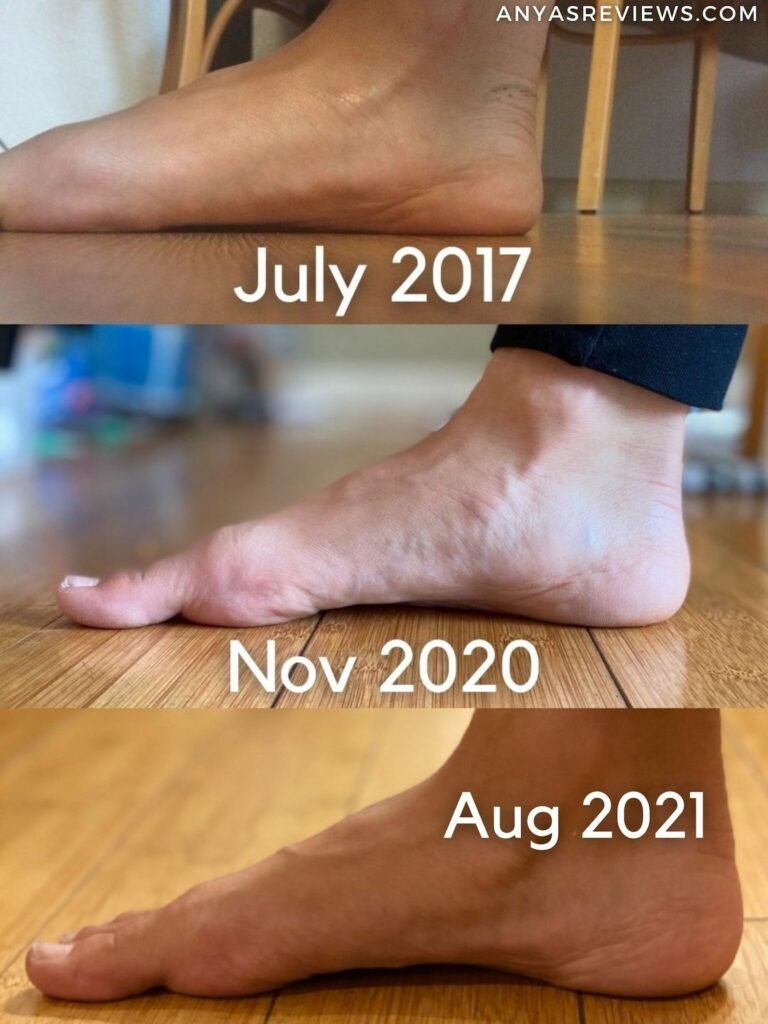
I am not here to tout going barefoot as a panacea for all people with foot pain. But we can ALL, no matter our current situation, be better informed about how our shoes and lifestyle choices affect us. I am prone to joint issues myself, which has affected my path toward healthy feet and better overall movement. But I’d still like to be able to chase my grandchildren someday, so I take every opportunity to use my body naturally. As anyone close to me will report, I can often be found traipsing around barefoot! And when I’m not, I’m in barefoot shoes 100% of the time. That means Birkenstocks are gone from my life, and even though we had a good run, I have no plans to come back to them.
So the next question is, what am I wearing instead of Birkenstocks? Here is a list of barefoot sandals that can be worn daily just like a Birkenstock sandal.
Barefoot Sandal Alternatives
Here are some barefoot sandals that are zero drop, with thin flexible soles, and a natural foot shape to them – for optimal foot function. But you don’t need to be limited to sandals! To get started with minimalist shoes, simply head to my home page.
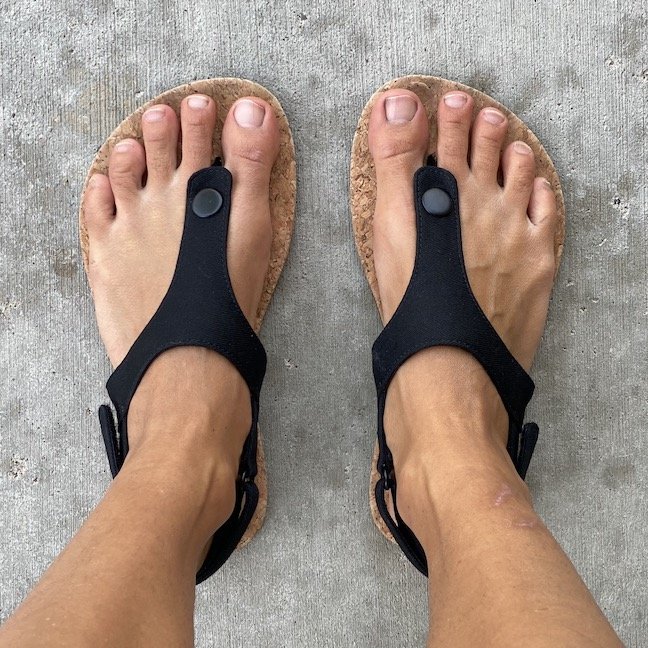
Feelgrounds Seaside Sandals (EU) – Sizes EU 35-49. The seaside sandal is vegan and available in tons of different colors! Read all my Feelgrounds reviews here.
Use code ANYA5 for 5% off your first order
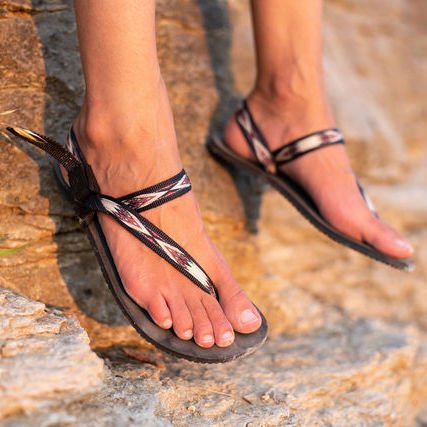
Earth Runners (US) – Sizes US 6-15. Love mine! Super comfortable. ANYA for 10% off. Full Earth Runners review here
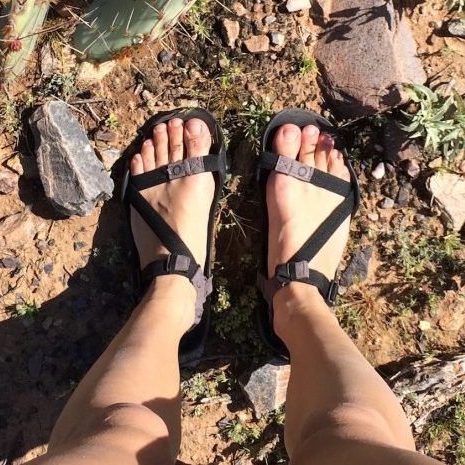
Xero Shoes (US) – Sizes US Womens 5-12, Mens 6-14. Read my Z-Trek review!
In Europe? Shop Xero Shoes EU here!
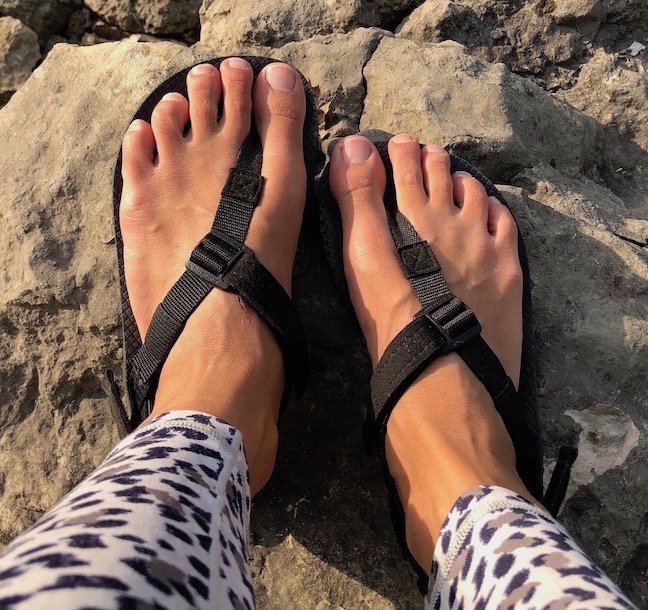
Shamma Sandals (US) – Sizes US Womens 5- Mens 14. Use code ANYASREVIEWS2023 for 10% off. I love this brand! Check out my Shamma reviews here.
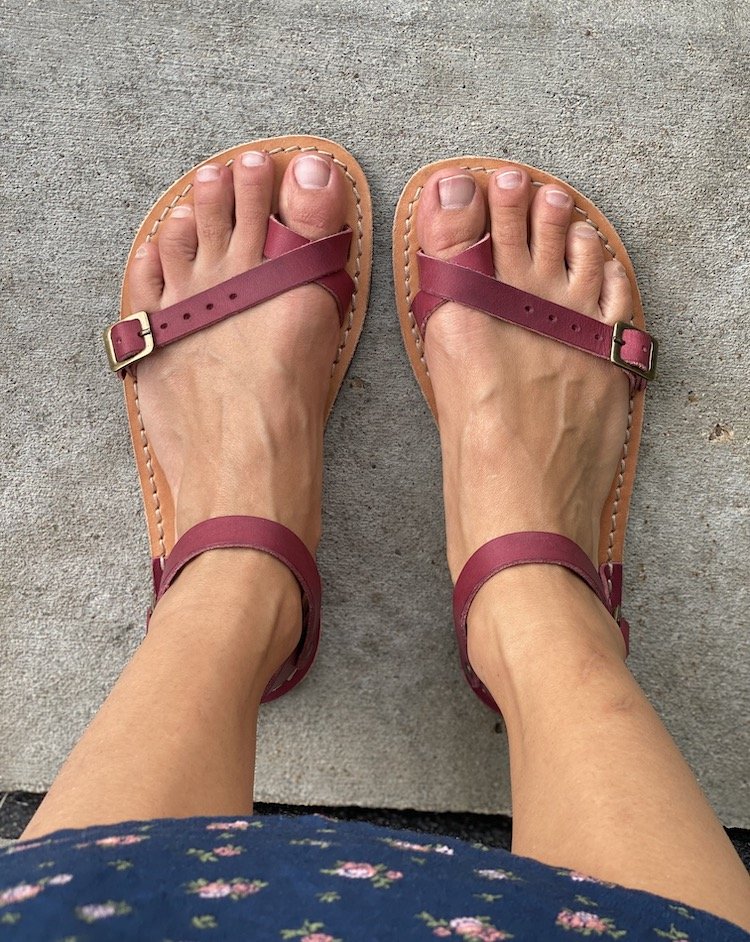
Crupon Sandals (Europe) – Sizes EU 35-41. The sandals linked here are barefoot friendly. The other models from Crupon are narrower in the toe box, but can still be made with a flat and flexible sole. There is also has an extra wide option! Use code ANYA for 10% off.
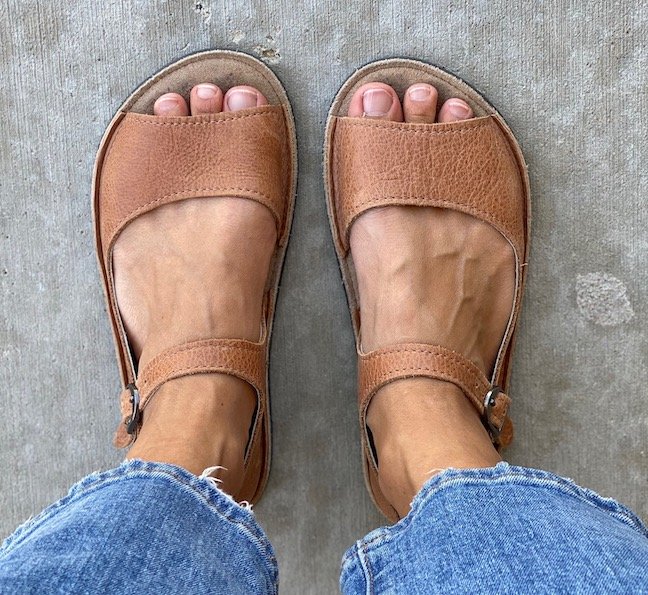
Softstar Solstice (US) – Sizes US 5U-12U and 3 width options. These sandals run big, most people size down and choose wide.
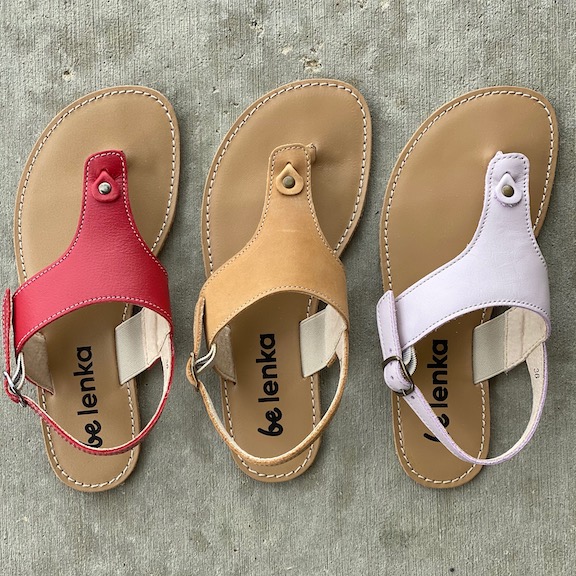
Be Lenka Promenade (EU) – Sizes EU 36-43. Use code ANYASREVIEWS for 5% off (returns are only accepted from within the EU and USA).
You can find Be Lenka sandals at Anya’s Shop!
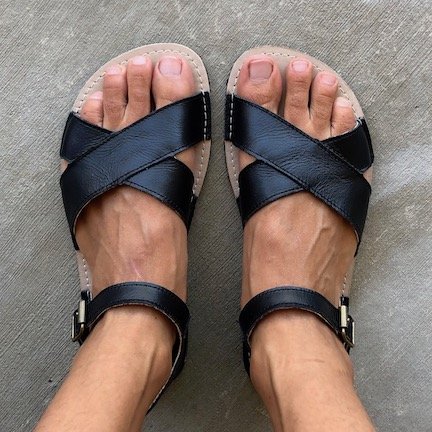
Zeazoo Sandals (EU) – Sizes EU 35-46. Use code ANYASREVIEWS for 5% off. You can find Zeazoo Sandals at Anya’s Shop!
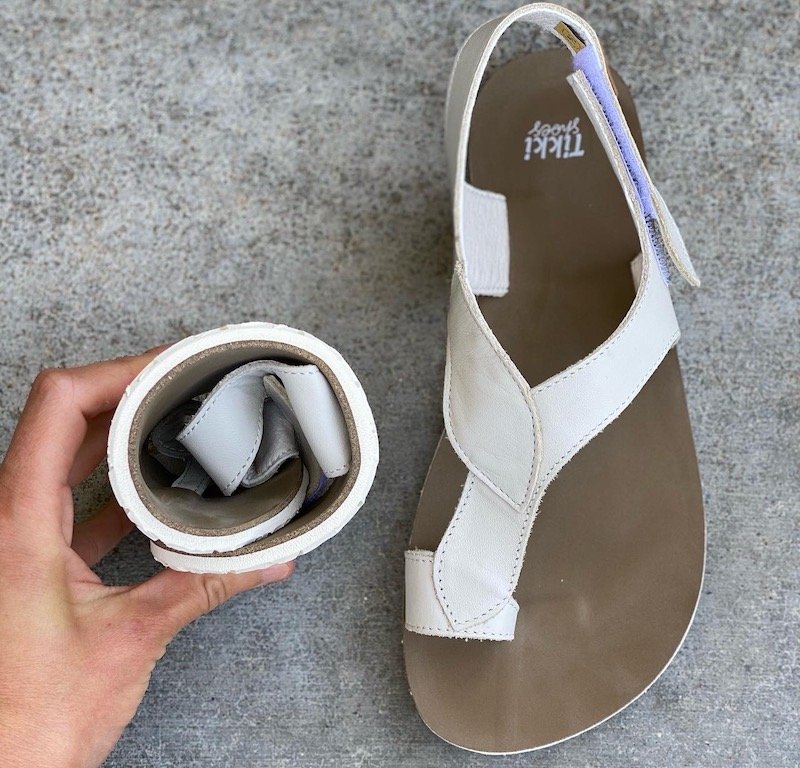
Lang. S by Tikki Shoes (EU) – Sizes EU 35-46. They are released each spring and have options for men, women, and big kids. Great choice for extra wide feet!
Use ANYALANG for 10% off
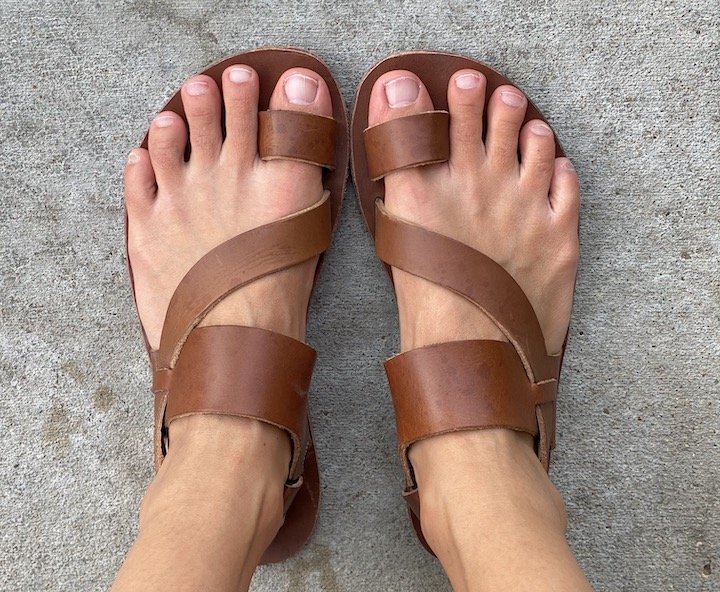
Vivobarefoot Opanka Sandal (Use this post to find your nearest Vivobarefoot e-shop) -Sizes US 5.5-11.5. Use code ANYASREVIEWS15 for 15% off *This model is only available seasonally. If it’s out currently, they’ll be back next warm season*
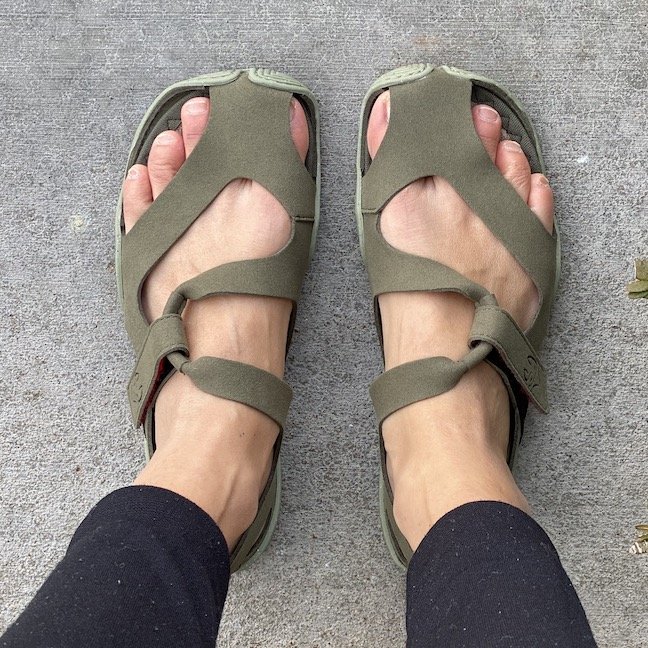
Wildling Feather (EU) – Sizes EU 36-48. The Feather sandals from Wildling are super lightweight and have great ground feel!
And these are just a handful of options! Click here to see a complete list of barefoot sandals with even more choices. And if you’re interested in natural foowear options for more than summertime, I have a multitude of barefoot shoe lists for different age groups, activities, and weather! You can find a barefoot shoe for almost any occasion!
Conclusion
If your feet are capable enough to not need supportive shoes like Birkenstocks you will be more comfortable in your daily life. While everyone’s unique bodies and experiences impact how feasible this is for them, most of us have a lot more control over it than we realize. But don’t take my word for it. Try it out and see if it’s right for you! It costs nothing to start going barefoot more often and exercising your feet. Your body will thank you for the attention.
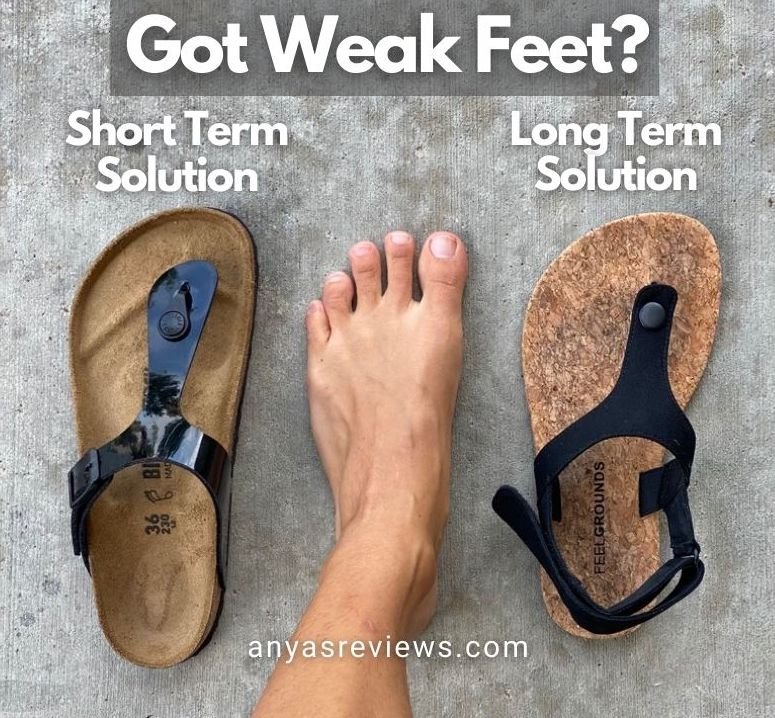
Reference Material
- The Benefits of Barefoot Shoes
- Foundational Foot Exercises
- How To Strengthen Your Feet With Floor Texture
- The Best Barefoot Shoes for Your Foot Type
- Whole Body Barefoot, by Katy Bowman
- Foot Health 101 Course from Gait Happens – I am also in their Foot Function Membership which I love
- How Feet Are Connected to the Pelvic Floor by Petra Fisher
- 3 Steps to Pain Free Feet from The Healthy Feet Alliance
Supporting Research
- Flip Flops Effect on Gait
- Musculoskeletal Rehabilitation Strategies
- Custom Foot Orthotic Intervention Caused Muscle Decrease
- How Over-Pronation May be a Dysfunctional Model
- Walking in Minimalist Shoes Strengthens Foot Muscles
- Shoes with A Narrow Toe Box Restrict Blood Flow to Heel
- The Biomechanics of Walking on Uneven Terrain
- Nerve Stimulation in Feet Affects Balance and Gait
- More on Nerve Stimulation in Feet and Locomotion
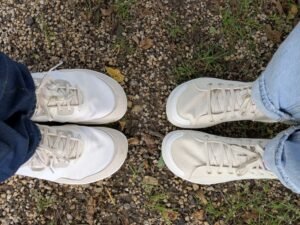
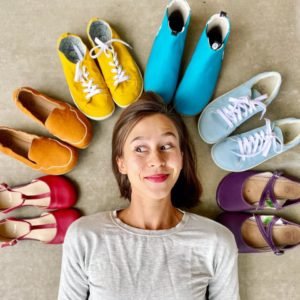

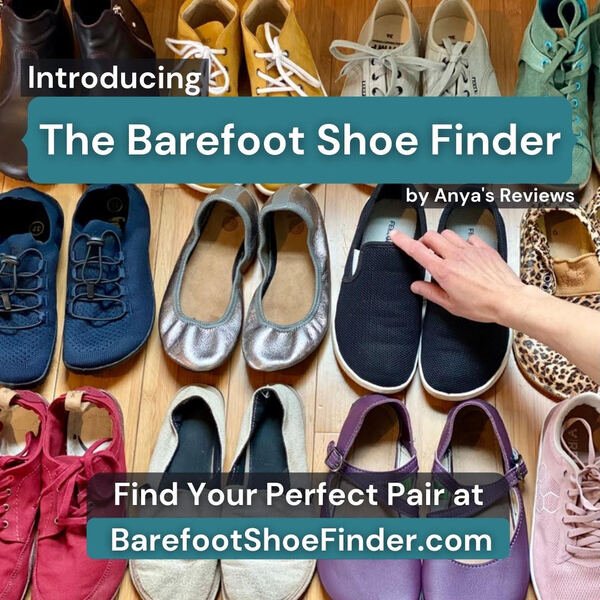
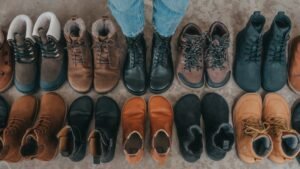
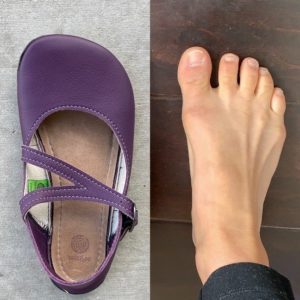


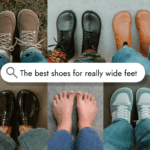

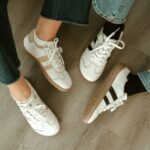

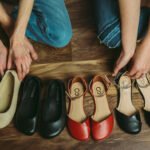
143 thoughts on “Why Birkenstocks Aren’t a Long Term Solution to Foot Pain”
Hi,
Thanks for all the information on this website – makes so much sense.
Do you have any advice for fat pad atrophy in the heel?
Thanks
From what I’ve learned from other foot specialists/podiatrists, when the fat pad goes it doesn’t come back. BUT you can build thickened skin there that acts as a cushion in the same way. It can really relieve discomfort (it did for me), but it takes a long time and lots of stimulation – i.e. barefoot walking on textures. Using a little extra cushion in your shoes when needed to stay out of pain is a perfectly acceptable way to deal with it.
Hi! I wanted to say that I found your post very intriguing! I am by no means any type of expert but my recommendation for any type of foot, leg, hip or back pain would be to immediately get x-rays of your feet. I wanted to share this because for me, 43, I suffered from severe hip pain for several years. I had always been told the I roll my feet when I walk so I was attempting to correct over pronation with specific shoes, massage therapy, excerises, chiropractor, etc, thinking my hip pain was caused by the pronation. I had also been to the orthopedic doctor, had an x-ray of my hip and it that showed my hip was fine but they gave me a cortisone shot, which helped for about 3 weeks. It was only after I went to the podiatrist, had an x-ray of my foot and found out that I had metatarsus adductus (condition where there bones in your feet are not straight) that I finally had the answer. My podiatrist recommended Haflinger shoes (similar to Birkenstocks) and I have not experienced any hip pain since. This was truly the greatest thing because I thought I was just going to have to live with the pain the rest of my life.
I guess the moral of the story is to recommended people get an x-ray of their feet before spending money on any type of costly shoes or costly orthotics. They may find that the source of their pain is something they never imagined. Metatarsus cannot be corrected unless you have pretty invasive foot surgery but Haflingers and Birkenstocks are a huge life saver for this condition.
Great point! Always better to find the root cause of your pain instead of chasing symptoms, and sometimes you need supportive footwear.
First, nice article. Well written and good at presenting a particular point of view.
However, every body is different. So, there is no one cure-all for problematic feet. Or, for most other physical alignments either. We always need to consider age, lifestyle, body type, and comorbidities when address our health issues.
As someone who was born with flat feet, suffers from gout, metatarsalgia, wide toe box, and infrequent plantar fasciitis, I’ve tried every shoe out there. I am very active outdoors and spend hours in the gardens. I squat a lot! I love being barefoot. But, honestly, the best thing for me is a combination of barefoot, as much as possible, except when I’m experiencing a metatarsalgia flare up, and Birkenstocks. In other words, exercising the foot then giving it rest as needed. So, depending on the body type and other factors, there’s not often just one simple answer.
I assume that this is all just your opinion. I find your medical advise to be questionable, and rather contradictory to most other reviews. If you don’t think that arch support is a good thing, just wait by till you get older. Flat soled unsupportive shoes are never a good idea.
And on the be subject of bad ideas, I find your fashion advice for alternative footwear to be even more questionable , but then that’s just my opinion.
Wore Birks for years without problems, now I find I have pain under one heel. I think the cork moulded footbed is to blame. Cork does not mould to the foot, it springs back. I know this because I make shoes myself. So any “moulding” will be minimal, confined to the thin layer of leather over the cork. The cup of the heel is inflexible and does not conform to my foot. It’s made for an “average foot” whatever that is.
I appreciate reading about your story and I am glad this kind of footwear works for you. I love going barefoot when I’m walking on natural surfaces (grass/woodlands/rocks, etc). But I find this philosophy of wearing barefoot shoes with no support, hard to get into. The surfaces we walk on in the modern day are not “natural” and are extremely flat – concrete/tarmac/flat wood. Walking in barefoot-like shoes on natural surfaces makes sense to me, but providing no support for your feet on flat and hard modern day surfaces, seems like a recipe for disaster and has caused me a lot of pain in the past. I have healthy strong feet, with relatively high arches. However, I also over-pronate so if I do not have stabile shoes or arch support, then it causes a lot of stress and pain on my knees. I don’t believe that forcing through this and just wearing flat shoes is going to help this or other people with similar issues.
I am so confused, this goes against everything I have learned about foot and body pain. Where are you getting this info to show that a flat shoes with less firm soles is a good thing? Not arguing but wondering if I was steared in the wrong direction with nerves and muscles. I always wear Hokas and nothing else!
Hi Katharine! You are fine, I understand the confusion. There is a lot of research there out there but it’s not definitive. As in, there is no “We did a study and now we know what the best shoe is.” But I highly recommend checking out Katy Bowman’s work for background info and the research that has been done that seems to indicate that bracing and supporting feet is not optimal. This podcast is a good place to start: https://www.nutritiousmovement.com/it-starts-with-feet-podcast-85/
You’re wrong. Podiatrists disagree with you. They obviously know more than you do. Stop trying to give medical advice.
Indeed some podiatrists do disagree with me, but others agree. My website is endorsed by several podiatrists that I have co-written articles with. You can find a few natural podiatrists here:
https://www.nwfootankle.com/
https://www.mountwaverleypodiatry.com.au/
https://rinaharris.com/
https://activelifeusa.com/pages/meet-dr-active
P.S. this is definitely not medical advice!
I have osteoarthritis at 39 and the stiffness is MUST in the Birkenstocks. It really is a good shoe because of this
If you truly don’t have motion in the foot then yes, stiffness is important. But it’s always worth exploring if any motion can be regained! I cowrote this article with a podiatrist on improving bunions, but the tips for mobilizing and strengthening can really be useful with any foot condition:
https://anyasreviews.com/how-to-help-your-bunions-if-you-dont-want-surgery/
What about varicose veins? I’m looking for a good shoe to stand on for concrete floors while substitute teaching. I had radio frequency ablation done on my legs for my veins and they still hurt. Would you recommend something like Birkenstocks for that? Thank you
I don’t know much about varicose veins unfortunately. In any case, you can try a “barefoot” shoe with more cushion, such as the options in this list: https://anyasreviews.com/best-barefoot-minimalist-shoe-brands-beginners/
Birkenstocks are like walking on concrete, even the soft footbed Birks don’t have that much support. If you have lower back pain or any issues with your joints pounding around all day on something that hard is not good. Birks put me in agony by the end of the day. NOT for me. I need something with a footbed that has some shock absorption.